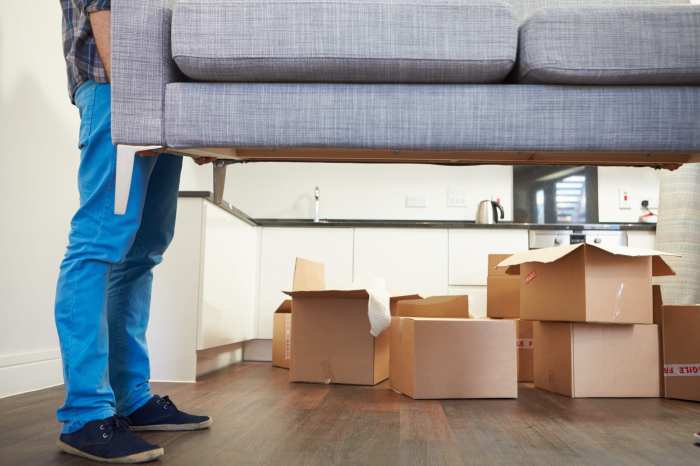Professional movers to move furniture offer a wide range of services to make your move as smooth and stress-free as possible. Whether you’re moving across town or across the country, hiring movers can save you time, effort, and the risk of damage to your furniture.
In this comprehensive guide, we’ll cover everything you need to know about hiring furniture movers, from choosing the right company to preparing for the move and unpacking and arranging your furniture in your new home.
Overview of Movers to Move Furniture

Professional furniture moving services are designed to assist individuals and businesses with the safe and efficient relocation of their furniture items. These services cater to a wide range of needs, from small-scale moves within a single property to large-scale relocations across cities or even countries.
The types of furniture moving services vary depending on the specific requirements of the client. Some common services include:
Residential Furniture Moving
Residential furniture moving services are tailored to the needs of homeowners and renters who are relocating to a new residence. These services typically involve packing, loading, transporting, and unloading furniture items, as well as assembling and disassembling furniture as needed.
Commercial Furniture Moving
Commercial furniture moving services are designed for businesses and organizations that need to relocate their office or commercial space. These services often involve the movement of heavy and specialized furniture, such as desks, cubicles, and machinery, and require careful planning and coordination to minimize downtime.
Specialty Furniture Moving
Specialty furniture moving services cater to the unique requirements of moving delicate or valuable furniture items, such as antiques, artwork, and pianos. These services involve specialized packing techniques, climate-controlled transportation, and experienced handlers to ensure the safe and secure relocation of these precious items.
Common Furniture Items Requiring Professional Moving Services
- Heavy and bulky furniture, such as sofas, beds, and armoires
- Fragile or delicate furniture, such as glass tables, mirrors, and artwork
- Antique furniture or furniture with sentimental value
- Specialized furniture, such as pianos, pool tables, and medical equipment
Benefits of Hiring Movers to Move Furniture

Hiring professional furniture movers offers numerous advantages that make the moving process easier and more efficient. These benefits include:
Time and Effort Saved:Delegating the moving task to professional movers frees up your valuable time and eliminates the physical effort required for packing, loading, and unloading furniture. This allows you to focus on other important aspects of the move, such as setting up your new home or managing other logistics.
Reduced Risk of Damage
Professional movers are experienced in handling and transporting furniture safely. They use specialized equipment and techniques to minimize the risk of damage during the move. By hiring movers, you can rest assured that your valuable furniture will be protected and transported with care.
If you’re looking for professional movers to move furniture, look no further. Our team of experienced movers will take care of your furniture moves with the utmost care and precision. We understand that your furniture is important to you, and we’ll treat it as if it were our own.
For more information on our furniture moves, visit our website at furniture moves .
Peace of Mind and Convenience
Hiring movers provides peace of mind by knowing that your furniture is in the hands of professionals. You can relax and focus on other aspects of the move without worrying about the safety and timely delivery of your furniture. Movers offer convenient services such as packing, unpacking, and arranging furniture in your new home, making the entire moving process more seamless and stress-free.
Choosing the Right Furniture Moving Company

Selecting a reliable and reputable furniture moving company is crucial to ensure a smooth and stress-free relocation. Here are some factors to consider when choosing a mover:
Experience and Expertise
Look for movers with extensive experience in handling furniture moving. A company with a proven track record of successfully completing furniture relocations will have the necessary expertise and skills to safely and efficiently transport your belongings.
Insurance and Licensing
Verify that the moving company is licensed and insured. This ensures that your furniture is protected against damage or loss during transit. Check for both general liability insurance and cargo insurance to cover any potential incidents.
Customer Reviews and Testimonials
Read online reviews and testimonials from previous customers to gain insights into the company’s service quality. Positive feedback from satisfied clients can provide valuable reassurance about the mover’s reliability and professionalism.
Multiple Quotes and Service Comparison
Obtain multiple quotes from different moving companies. This allows you to compare services, pricing, and availability. Consider factors such as the number of movers, truck size, and any additional services offered.
Preparing for a Furniture Move
Moving furniture can be a daunting task, but with careful planning and preparation, it can be a smooth and successful process. Here’s a comprehensive checklist to help you prepare for a furniture move:
Creating a Checklist
- Create a comprehensive checklist of tasks to prepare for a furniture move, including packing, protecting floors and walls, and labeling and organizing furniture.
- Pack furniture carefully to ensure safe transportation, using appropriate packing materials and techniques.
- Protect floors and walls during the move by using floor runners, moving blankets, and corner guards.
- Label and organize furniture for easy identification, using tags or stickers.
Packing Techniques
Proper packing is crucial for protecting your furniture during a move. Use sturdy boxes or crates that are appropriately sized for the furniture pieces.
When you’re moving furniture, hiring movers is a great way to ensure that your belongings are handled with care. But one question you may have is whether or not you should tip the movers. While tipping is not required, it is a common way to show your appreciation for their hard work.
If you’re wondering how much to tip, you can check out this helpful guide: do you tip furniture delivery . Ultimately, the decision of whether or not to tip is up to you, but it’s always a nice gesture to show your movers that you appreciate their work.
- Wrap furniture in protective materials such as bubble wrap, moving blankets, or foam padding.
- Disassemble furniture when possible, removing legs, arms, and other detachable parts.
- Securely tape and label boxes, indicating the contents and the room they belong to.
Protecting Floors and Walls
Protecting your floors and walls during a move is essential to prevent damage. Here are some tips:
- Lay down floor runners or moving blankets to protect floors from scratches and dents.
- Use corner guards to protect walls from damage caused by furniture corners.
- Cover furniture with moving blankets to prevent scratches and dust accumulation.
Labeling and Organizing
Labeling and organizing furniture will make it easier to identify and unload at your new location. Use tags or stickers to label each piece of furniture, indicating its contents and the room it belongs to.
- Create a master list of all furniture items, including their labels and corresponding room assignments.
- Organize furniture into designated areas, such as bedrooms, living rooms, and kitchens.
- Label boxes and furniture with clear and visible markings.
Executing the Furniture Move: Movers To Move Furniture
Executing a furniture move requires meticulous planning and careful execution. This involves loading and unloading furniture onto the moving truck, handling heavy and bulky items safely, securing furniture during transportation, and navigating tight spaces and stairs.
Loading and Unloading Furniture
Proper loading and unloading techniques ensure the safety of both furniture and individuals involved. Begin by disassembling furniture that can be easily taken apart, such as tables and beds, to save space and reduce the risk of damage. Wrap all furniture items in protective materials like blankets or bubble wrap to prevent scratches and dents.
When loading furniture onto the truck, distribute weight evenly and secure items with straps or ropes to prevent shifting during transit. Heavy items should be placed at the bottom, with lighter items on top. Use dollies or hand trucks to move heavy furniture to avoid strain or injury.
Unloading furniture follows similar principles. Unpack and reassemble furniture in the designated rooms, taking care to place items gently to avoid damage. Inspect furniture for any signs of damage and report any issues to the moving company immediately.
Handling Heavy and Bulky Furniture
Handling heavy and bulky furniture requires extra care and caution. Recruit additional help when necessary, especially for large or awkward items. Use proper lifting techniques, bending at the knees and keeping your back straight. Avoid twisting or jerking movements that could strain muscles or cause injury.
Consider using furniture sliders or blankets to move heavy items across floors without causing damage. Sliders reduce friction, making it easier to slide furniture, while blankets protect both the furniture and the floor.
Securing Furniture During Transportation, Movers to move furniture
Securing furniture during transportation is crucial to prevent damage and ensure the safety of the load. Use straps, ropes, or bungee cords to tie down furniture to the truck’s walls or floor. Fill any empty spaces with blankets or pillows to prevent items from shifting or rattling.
Drive carefully, avoiding sudden stops or sharp turns that could cause furniture to move or fall. If possible, secure the truck’s tailgate to prevent furniture from sliding out during transit.
Navigating Tight Spaces and Stairs
Navigating tight spaces and stairs requires careful planning and coordination. Measure furniture items to ensure they will fit through doorways and hallways. If necessary, disassemble furniture or remove doors temporarily to create more space.
When moving furniture up or down stairs, carry it feet first, keeping the heavier end at the bottom. Use a furniture dolly or hand truck if possible to reduce strain. Take your time and be cautious, as stairs can be hazardous.
Unpacking and Arranging Furniture
Unpacking and arranging furniture is a crucial step in the moving process that requires careful planning and execution. By following efficient unpacking techniques and thoughtfully placing furniture, you can create a cohesive and inviting living space that meets your functional and aesthetic needs.
To begin, prioritize unpacking essential items such as bedding, toiletries, and kitchenware. This will ensure your immediate comfort and functionality in the new space. For larger items like furniture, it’s advisable to follow the assembly instructions meticulously and use appropriate tools to avoid damage.
Furniture Placement
When arranging furniture, consider both aesthetics and functionality. Start by placing larger pieces, such as sofas and beds, against walls or in focal points of the room. Smaller pieces, like chairs, tables, and lamps, can be used to fill in spaces and create a sense of balance.
Consider the flow of traffic when placing furniture. Avoid blocking walkways or creating obstacles that could hinder movement. Additionally, pay attention to natural light sources and position furniture to maximize their benefits. For example, place seating areas near windows to take advantage of natural light.
Creating a Cohesive Space
To create a cohesive living space, use furniture and decor that complement each other in terms of style, color, and texture. Experiment with different arrangements and combinations until you find a layout that feels both comfortable and visually appealing.
Accessorize with throw pillows, blankets, and artwork to add personality and warmth to the space. Consider using plants to bring in a touch of nature and purify the air. By following these tips, you can unpack and arrange furniture efficiently, creating a functional and inviting living space that reflects your style and needs.
Moving furniture can be a daunting task, especially if you have a lot of it. That’s where movers come in. They can help you move your furniture safely and efficiently. If you’re looking for a reputable and experienced mover, look no further than raymond y flanigan furniture . They have a team of experienced professionals who can handle any size move.
They also offer a variety of services, including packing, unpacking, and storage. So whether you’re moving across town or across the country, movers can help you make your move a breeze.
Final Review
Moving furniture can be a daunting task, but it doesn’t have to be. By following the tips and advice in this guide, you can ensure that your furniture move is safe, efficient, and stress-free.
FAQ Explained
How much do furniture movers cost?
The cost of furniture moving services will vary depending on the size and distance of your move, as well as the number of items you need to move. However, you can expect to pay between $100 and $500 for a local move and between $500 and $1,000 for a long-distance move.
What should I look for when choosing a furniture moving company?
When choosing a furniture moving company, you should look for a company that is reputable, reliable, and experienced. You should also make sure that the company is licensed and insured. It’s also a good idea to get quotes from multiple companies before making a decision.
How can I prepare for a furniture move?
To prepare for a furniture move, you should start by packing your belongings. Make sure to pack your items securely and label each box with its contents. You should also disassemble any furniture that can be disassembled. On the day of the move, be sure to clear a path for the movers and make sure that all of your belongings are ready to be moved.